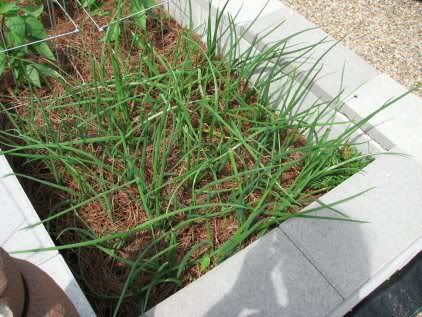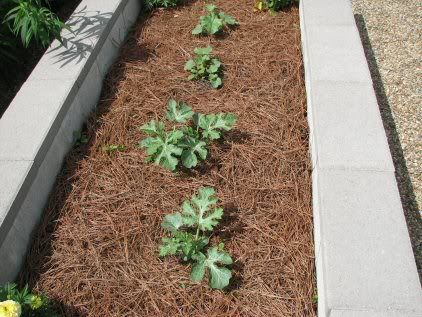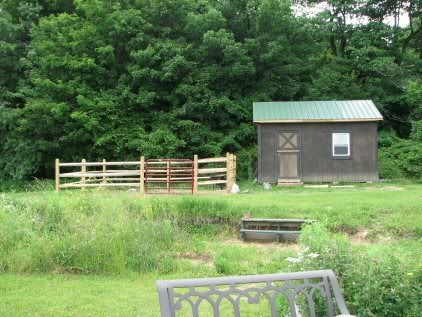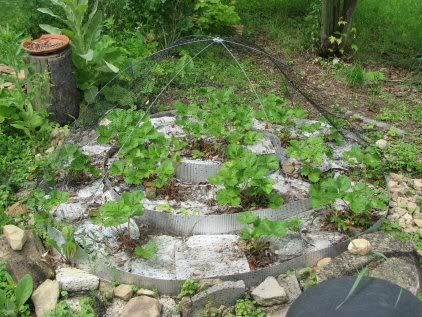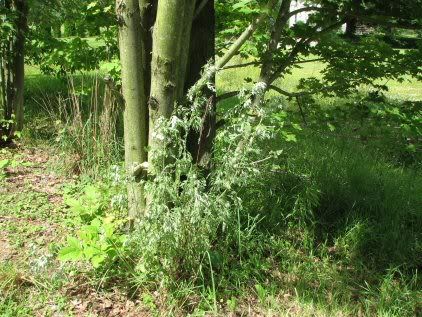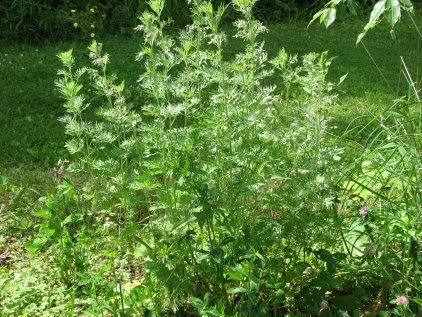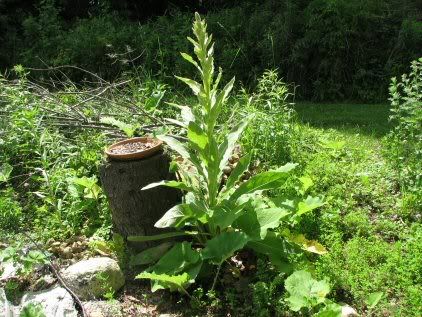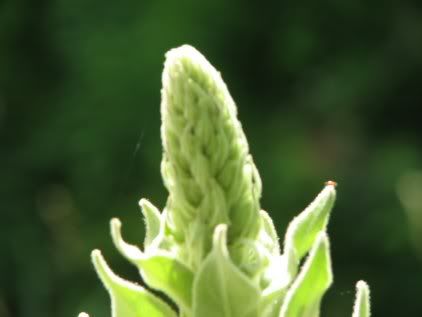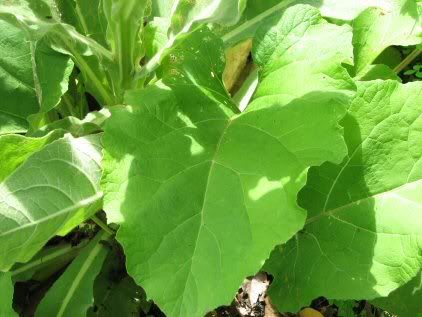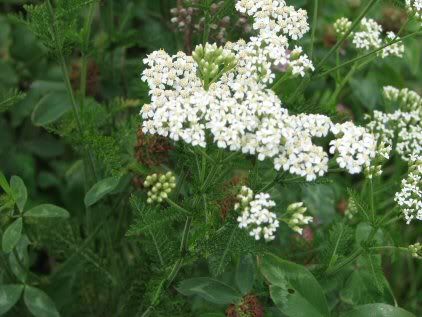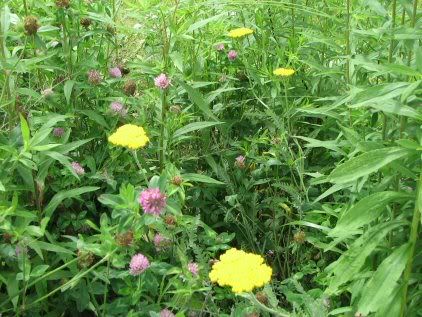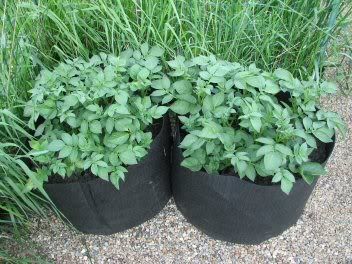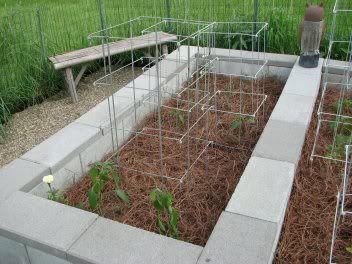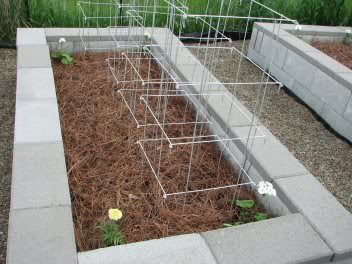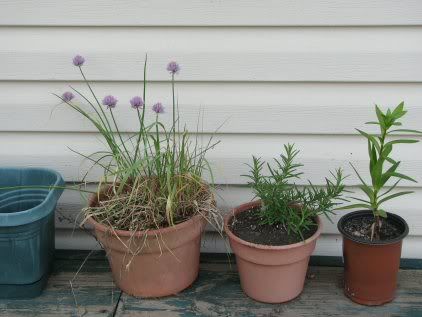After reading
We're Not Even Medieval, a most excellent post over at Daily Kos, I felt the need to expand on this topic. There are more (sometimes disturbing) comparisons to be made between people today and those who lived during Medieval times.
For some reason, we have a tendency to view our ancestors as somehow less intelligent than ourselves. Whether we believe that modern humans have been around for 6,000 or 100,000 years, we generally think of those who came before us as primitive and/or destitute. Remember, though, that we're talking about the Middle Ages here, around the 12th century some 800-900 years ago.
In Western Europe, this was the time of kings and feudal lords, serfs and peasants. Much of Eastern Europe and Northern Africa was part of the Byzantine Empire. In the Middle East, this was the period of the first three Crusades. In Asia, this was the time of the Jinn Dynasty. In North America, mound builders (near modern-day St. Louis) had a population of up to 40,000, the largest Native American city prior to European "discovery". To the Southwest, cliff dwellings for thousands were built. In Central Mexico, the Toltecs ruled. The world's population during this period is
estimated to be 300-350 million.
Without power tools, cranes, or bulldozers, these people managed to build castles, cathedrals, monasteries, and even hospitals that stand to this day. How many modern buildings will stand 900 years from now?
Because the very word "electricity" would not be coined for another 500 years, these people lived without the luxuries of air conditioning, fans, refrigerators, microwaves, blenders, toasters, vacuum cleaners, washing machines, dryers, dishwashers, radio, television, etc. How many things from that list would you consider a necessity? For most modern people, the loss of power means the complete loss of normalcy, affecting everything: getting water, staying comfortable, waste removal, cooking, and even cleaning. Only in the past century has our society abandoned the ancient basic necessities of a household and become completely reliant on the grid.
George Clooney's character in the movie Oh, Brother Where art Thou? said this about the soon-to-come electrical grid:
"Everything's gonna be put on electricity and run on a paying basis. Out with the old spiritual mumbo jumbo, the superstitions, and the backward ways. We're gonna see a brave new world where they run everybody a wire and hook us all up to a grid. Yes, sir, a veritable age of reason. Like the onethey had in France. Not a moment too soon."
I have no problem with modern conveniences. The problem is, many have become necessities. We as a society no longer are prepared or even know how to live without electricity and in some cases have made the old ways impossible. How many modern homes have
- a woodstove or fireplace, once literally the hearth of the home? Our so-called fireplace is more decorative than functional and doesn't work well without the vent fan running.
- access to water without electricity? Unless you have a hand pump or a spring on your property, you're at the mercy of the power company.
- an alternative to the flush toilet? In most areas of the U.S., outhouses are illegal.
- an alternative to the automatic washing machine or even a clothesline? Without power, there's no running water and no hot water, and those expensive appliances are suddenly worthless.
We've arranged a civilization in which most crucial elements profoundly depend on science and technology. We have also arranged things so that almost no one understands science and technology. This is a prescription for disaster. We might get away with it for a while, but sooner or later this combustible mixture of ignorance and power is going to blow up in our faces. ~ Carl Sagan
If it keeps up, man will atrophy all his limbs but the push-button finger. ~ Frank Lloyd Wright
We have many technological advancements at our fingertips, but not many of us know enough about how they work to recreate them. How long did it take Tom Hanks in
Cast Away to start a fire? I remember vividly the scene at the end when he picks up a cigarette lighter and flicks it to life, realizing how much he had taken for granted. In just 3-4 generations, we have almost lost the practical knowledge necessary for survival that was accumulated over thousands of years.
-------------------------------------------------------------------
Another drastic difference between modern and medieval people is food. During the 12th century (and well beyond), the vast majority of food was local, in season, and organic. Certainly, there was trade, but daily necessities were generally at hand. There was no grocery store in town; in fact, there weren't many towns but small villages of 20-30 families surrounding a manor (at least in medieval Europe). Most peasants never traveled beyond their own village or the next.
Instead of groceries, there was a cow or goat, chickens, hogs, perhaps a beehive, and of course a garden. Farming was the main occupation of most peasants, both on their own plot and for the manor. Their diet was heavy in whole grains — especially barley, rye, and wheat — beans, peas, home-grown vegetables, some fruit, a little fish, and occasionally some pork or mutton. Ale was consumed throughout the day by all ages.
Compare this to our modern lifestyle.
In the U.S., the average grocery store’s produce travels nearly 1,500 miles between the farm where it was grown and your refrigerator. About 40% of our fruit is produced overseas and, even though broccoli is likely grown within 20 miles of the average American’s house, the broccoli we buy at the supermarket travels an average 1,800 miles to get there. Notably, 9% of our red meat comes from foreign countries, including locations as far away as Australia and New Zealand. Imports from around the world ensure that supermarket shelves look the same week in week out, regardless of the season.
Mega-farms owned by corporations practice monoculture using chemical fertilizer and pesticides, human sewage, and genetically modified seeds. In the past 50 years, conventional agriculture has changed to high chemical use and vegetables have become less nutritious and less flavorful. They are harvested before they are ripe and shipped long distances. They never develop the wonderful flavors nor the high nutritional content that occur naturally in organic, locally produced fresh vegetables. Natural diversity is being lost at an alarming rate. The soil, water, and air have been contaminated with poisons.
Factory farms raising animals operate in much the same way. Many of today's farms are actually large industrial facilities, not the green pastures and red barns that most Americans imagine. These consolidated operations are able to produce food in high volume but have little to no regard for the environment, animal welfare, or food safety. Unnaturally large numbers of animals are confined closely together. Cattle feedlots generally contain thousands of animals in one place, while many egg-laying businesses house one million or more chickens. The main animals for such operations are cows, pigs, chickens and turkeys, but this practice is also applied to sheep, goats, rabbits, and various types of poultry. Low doses of antibiotics are administered regularly to animals in a preemptive move to ward off the diseases bred by unnatural, unsanitary conditions. In addition to preventive medicines, animals are fed hormones and antibiotics to promote faster growth.
From Why Eat Organic Food:
What happens to the health of the animals, plants, microorganisms, soil, oceans, and atmosphere happens to all humans as well. There is no person on Earth who is immune to the effects of an unhealthy environment, no matter how much technology or wealth they may possess. When the food we eat is polluted, we carry that pollution in our bodies; some of it remains there and accumulates. It is passed along from generation to generation, from mother and father to children in various forms.
-----------------------------------------------------------------------
Being a housewife in medieval times (in fact, up to and including the 21st century for some) meant having many skills:
- butchering
- food-preserving
- brewing ale
- making wine
- making cheese
- baking bread
- growing vegetables and herbs
- tending animals
- beekeeping
- milking
- churning butter
In addition to skills and knowledge that dealt with food, she also had to be proficient at
- midwifery
- general medicine, including plant identification
- spinning thread
- weaving
- sewing
- making soap
- making candles or rush lights
Notice that cleaning the house was not a priority. A peasant cottage was generally small, 1-2 rooms at most. The floor was dirt and there were no windows. Furniture was scarce, and beds consisted of piles of straw.
Neither was babysitting high on the list. In medieval times, children were viewed as miniature adults and were given responsibilities at an early age. This apprentice-like system provided the training necessary to this way of life. Daily survival was hard work for everyone, so as soon as children were able, they were expected to pull their weight.
A 12th century peasant housewife was responsible for most things necessary for her family's survival, aside from shelter, and what comfort they could afford.
Contrast to the 21st century, when the average woman might know how to do one thing on the list above, if that. Certainly, women have come a long way in the past 900 years, from a father or husband's property to near equality. Women now can own property, can vote and hold office, and have considerably more choice when it comes to reproduction.
But I'd guess that there were no
Desperate Housewives in the 12th century, nor women lining up to see a doctor for antidepressants, nor worries about "quality time" with the kids. Our ancestresses were no strangers to multitasking or hard work, and their contributions to the household were probably never considered "disposable" income. Yes, inventive machines have lightened the workload, but what good have we done with that extra time? In how many ways has removing the modern woman from the hearth poisoned our world?
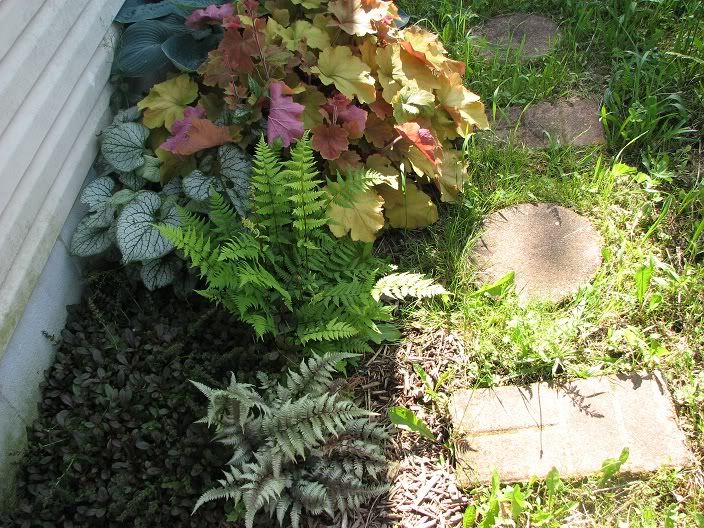 From top left to bottom right: Hosta, caramel heuchera, Jack Frost brunnera, Japanese fern, chocolate chip ajuga, and painted lady. I plan to put in a proper walkway this year.
Straight ahead from the front door is the new arch. Eventually there will be a walkway/path to the steps leading to the pergola that will be on top of the hill.
From top left to bottom right: Hosta, caramel heuchera, Jack Frost brunnera, Japanese fern, chocolate chip ajuga, and painted lady. I plan to put in a proper walkway this year.
Straight ahead from the front door is the new arch. Eventually there will be a walkway/path to the steps leading to the pergola that will be on top of the hill.
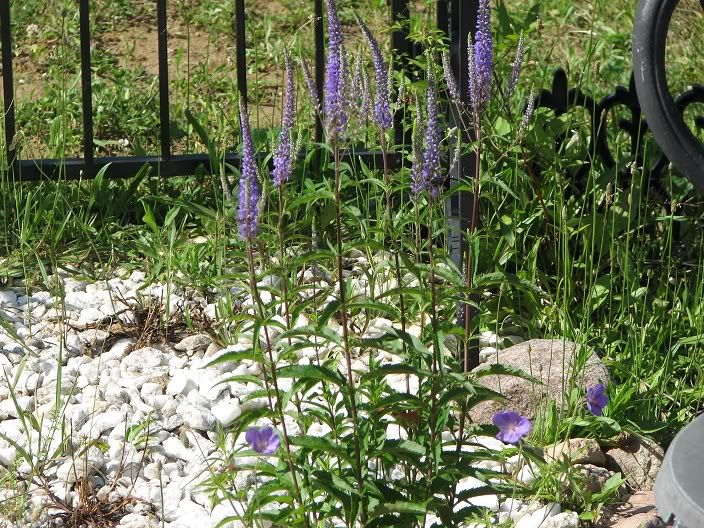 Both the veronica and the geranium are volunteers that have been coming up in the gravel for the past 3 years or so. Just above them, climbing up either side of the arch, is dark purple clematis (Jackmani?), which apparently prefers the new arch because it is blooming more profusely than ever.
To the right of the arch, there is an incomplete bed:
Both the veronica and the geranium are volunteers that have been coming up in the gravel for the past 3 years or so. Just above them, climbing up either side of the arch, is dark purple clematis (Jackmani?), which apparently prefers the new arch because it is blooming more profusely than ever.
To the right of the arch, there is an incomplete bed:
 The bigger bush on the right is Wine and Roses weigela. It's quite spectacular when it blooms. The medium green/gray bush is a blue caryopteris, which gets small light blue flowers. The smaller one is Midnight Wine weigela. There are a couple of Scarlet and white pinks in the front (back from this view).
Moving to the right, here's the view down the front walk (more details below):
The bigger bush on the right is Wine and Roses weigela. It's quite spectacular when it blooms. The medium green/gray bush is a blue caryopteris, which gets small light blue flowers. The smaller one is Midnight Wine weigela. There are a couple of Scarlet and white pinks in the front (back from this view).
Moving to the right, here's the view down the front walk (more details below):
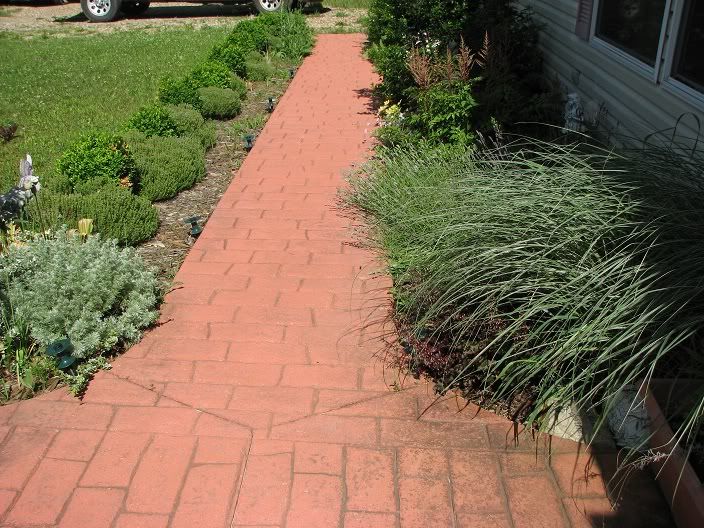 Along the left, starting at the bottom: Artemesia in front of a creeping euonymous; just peeking out from behind, you can see the tops of the daffodil fronds banded over for the summer; alternating mother-of-thyme and English boxwood; at the very end, black-eyed susans are just starting to get buds. I still haven't figured out what to plant right along the walk, but it needs to be colorful most of the summer and definitely perennial.
Along the right, starting at the bottom: Zebra grass; heuchera; lavender; astilbe; pinks; bleeding heart; another heuchera; holly and sweet woodruff.
Along the left, starting at the bottom: Artemesia in front of a creeping euonymous; just peeking out from behind, you can see the tops of the daffodil fronds banded over for the summer; alternating mother-of-thyme and English boxwood; at the very end, black-eyed susans are just starting to get buds. I still haven't figured out what to plant right along the walk, but it needs to be colorful most of the summer and definitely perennial.
Along the right, starting at the bottom: Zebra grass; heuchera; lavender; astilbe; pinks; bleeding heart; another heuchera; holly and sweet woodruff.
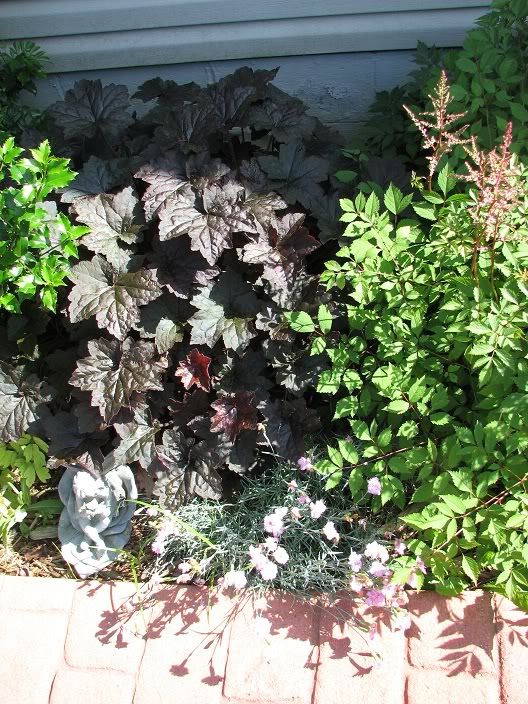 The big Purple Palace heuchera close up.
The big Purple Palace heuchera close up.
 The astilbe patch. There are actually 2 different plants, but the one in front is by far the bigger. Right now (not shown in this photo), it's in full bloom with pinkish lavender flowers.
The astilbe patch. There are actually 2 different plants, but the one in front is by far the bigger. Right now (not shown in this photo), it's in full bloom with pinkish lavender flowers.
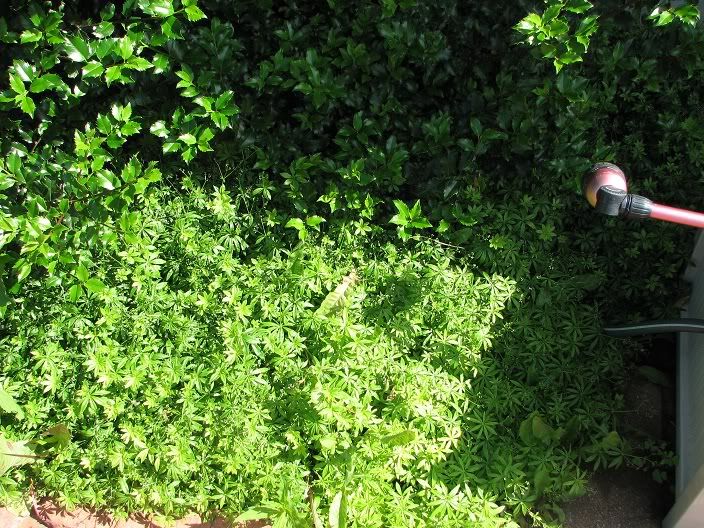 The sweet woodruff has really filled in nicely around the holly bushes.
At the far end of the walk on the right is the catmint:
The sweet woodruff has really filled in nicely around the holly bushes.
At the far end of the walk on the right is the catmint:
 Now a couple of shots of the back yard. Buddha is back out on the deck:
Now a couple of shots of the back yard. Buddha is back out on the deck:
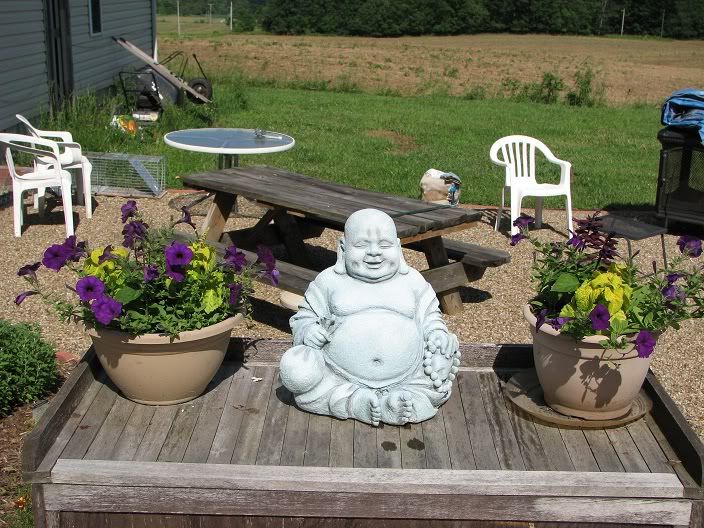 The pots both have the same mixture of purple wave petunias with a couple of dark purple salvia and lime green coleus.
The pots both have the same mixture of purple wave petunias with a couple of dark purple salvia and lime green coleus.
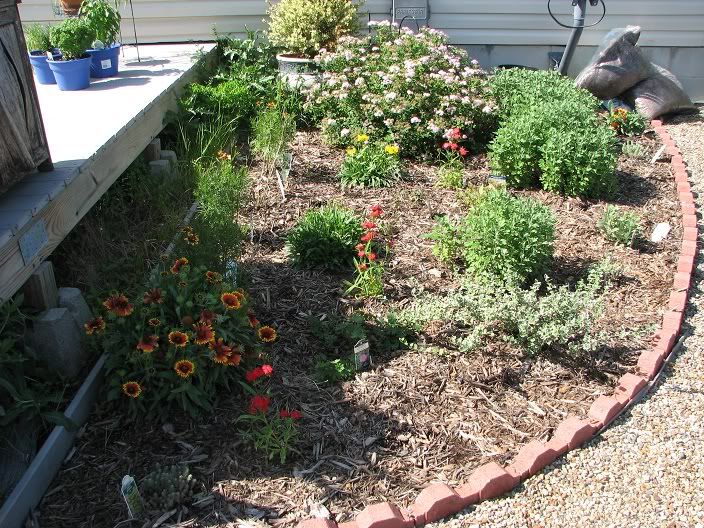 This is John's big bed between the deck and patio. There are Goblin blanket flowers, Scarlet pinks, Little Monster geraniums, two different kinds of coreopsis, a creeping euonymous, several sedum, and then the bushes. The 3 green ones to the right are mums. The big one in the middle with the pink flowers is a Little Princess spirea, and the potted bush is a variegated boxwood.
Along the other edge of the deck we have planted the small bed with yarrow, 2 red and 2 pink, with a white one and a yellow one soon to be moved from the old herb bed. No photo, sorry.
So those are the flower beds as they look this year. Just a few more holes to fill in, and these beds will be finished. They're really starting to look as though we've actually lived here for almost 10 years, I think.
This is John's big bed between the deck and patio. There are Goblin blanket flowers, Scarlet pinks, Little Monster geraniums, two different kinds of coreopsis, a creeping euonymous, several sedum, and then the bushes. The 3 green ones to the right are mums. The big one in the middle with the pink flowers is a Little Princess spirea, and the potted bush is a variegated boxwood.
Along the other edge of the deck we have planted the small bed with yarrow, 2 red and 2 pink, with a white one and a yellow one soon to be moved from the old herb bed. No photo, sorry.
So those are the flower beds as they look this year. Just a few more holes to fill in, and these beds will be finished. They're really starting to look as though we've actually lived here for almost 10 years, I think.



